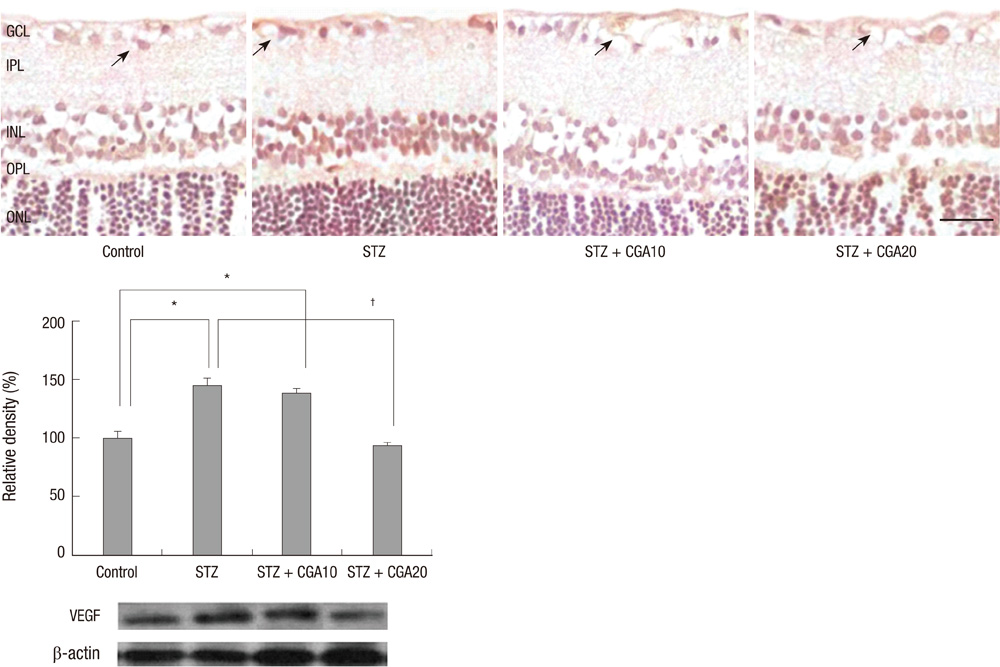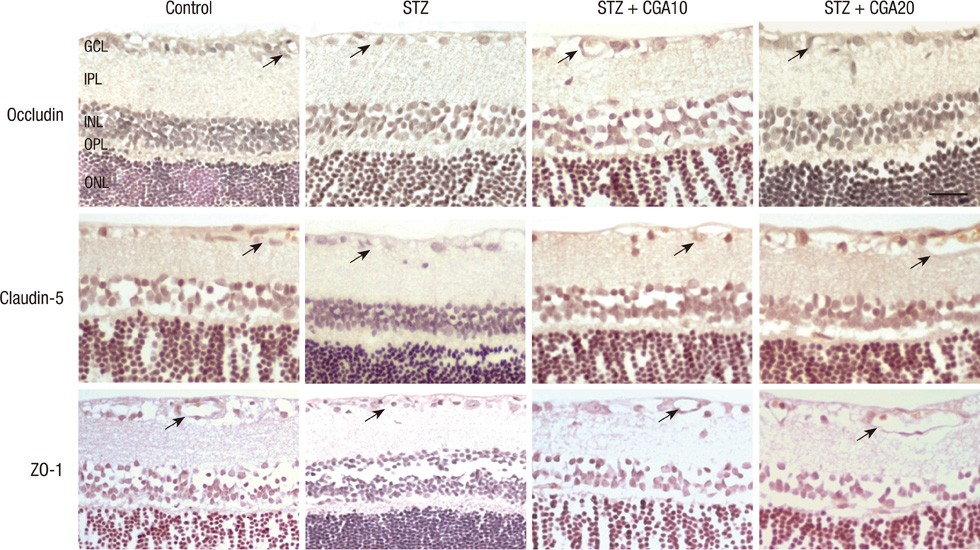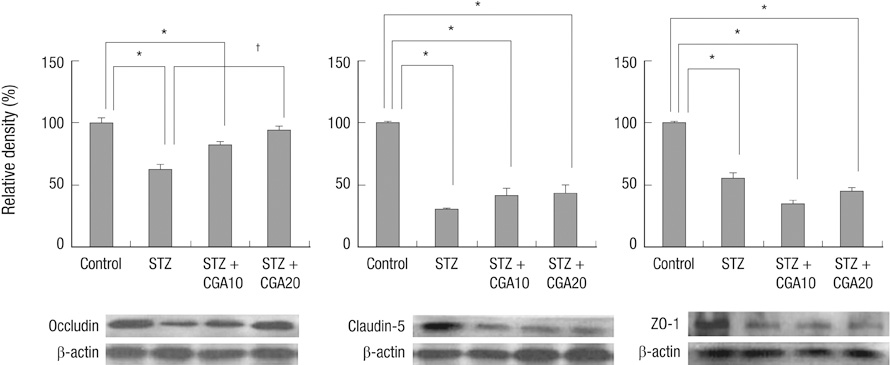J Korean Med Sci.
2013 Apr;28(4):608-613. 10.3346/jkms.2013.28.4.608.
Chlorogenic Acid Decreases Retinal Vascular Hyperpermeability in Diabetic Rat Model
- Affiliations
-
- 1Department of Ophthalmology, Seoul National University College of Medicine, Seoul National University Hospital, Seoul, Korea.
- 2HanGil Eye Hospital, Incheon, Korea.
- 3Department of Ophthalmology, Seoul National University Bundang Hospital, Seongnam, Korea. jiani4@snu.ac.kr
- KMID: 1786971
- DOI: http://doi.org/10.3346/jkms.2013.28.4.608
Abstract
- To evaluate the effect of chlorogenic acid (CGA), a polyphenol abundant in coffee, on retinal vascular leakage in the rat model of diabetic retinopathy, Sprague-Dawley rats were divided into four groups: controls, streptozotocin-induced diabetic rats, and diabetic rats treated with 10 and 20 mg/kg chlorogenic acid intraperitoneally daily for 14 days, respectively. Blood-retinal barrier (BRB) breakdown was evaluated using FITC-dextran. Vascular endothelial growth factor (VEGF) distribution and expression level was evaluated with immunohistochemistry and Western blot analysis. Expression of tight junction proteins, occludin and claudin-5, and zonula occludens protein, ZO-1 was also evaluated with immunohistochemistry and Western blot analysis. BRB breakdown and increased vascular leakage was found in diabetic rats, with increased VEGF expression and down-regulation of occludin, claudin-5, and ZO-1. CGA treatment effectively preserved the expression of occludin, and decreased VEGF levels, leading to less BRB breakdown and less vascular leakage. CGA may have a preventive role in BRB breakdown in diabetic retinopathy by preserving tight junction protein levels and low VEGF levels.
Keyword
MeSH Terms
-
Animals
Blood-Retinal Barrier/*drug effects
Chlorogenic Acid/metabolism/*pharmacology
Claudin-5/metabolism
Dextrans/chemistry
Diabetes Mellitus, Experimental/complications/metabolism/*pathology
Diabetic Retinopathy/etiology/prevention & control
Down-Regulation
Fluorescein-5-isothiocyanate/chemistry
Male
Occludin/metabolism
Rats
Rats, Sprague-Dawley
Retina/*metabolism
Tight Junction Proteins/metabolism
Vascular Endothelial Growth Factor A/metabolism
Zonula Occludens-1 Protein/metabolism
Claudin-5
Occludin
Tight Junction Proteins
Vascular Endothelial Growth Factor A
Zonula Occludens-1 Protein
Chlorogenic Acid
Fluorescein-5-isothiocyanate
Dextrans
Figure
Reference
-
1. Antonetti DA, Barber AJ, Khin S, Lieth E, Tarbell JM, Gardner TW. Vascular permeability in experimental diabetes is associated with reduced endothelial occludin content: vascular endothelial growth factor decreases occludin in retinal endothelial cells: Penn State Retina Research Group. Diabetes. 1998. 47:1953–1959.2. Barber AJ, Antonetti DA. Mapping the blood vessels with paracellular permeability in the retinas of diabetic rats. Invest Ophthalmol Vis Sci. 2003. 44:5410–5416.3. Barber AJ, Antonetti DA, Gardner TW. Altered expression of retinal occludin and glial fibrillary acidic protein in experimental diabetes: the Penn State Retina Research Group. Invest Ophthalmol Vis Sci. 2000. 41:3561–3568.4. Antonetti DA, Barber AJ, Hollinger LA, Wolpert EB, Gardner TW. Vascular endothelial growth factor induces rapid phosphorylation of tight junction proteins occludin and zonula occluden 1: a potential mechanism for vascular permeability in diabetic retinopathy and tumors. J Biol Chem. 1999. 274:23463–23467.5. Harhaj NS, Felinski EA, Wolpert EB, Sundstrom JM, Gardner TW, Antonetti DA. VEGF activation of protein kinase C stimulates occludin phosphorylation and contributes to endothelial permeability. Invest Ophthalmol Vis Sci. 2006. 47:5106–5115.6. Hirase T, Staddon JM, Saitou M, Ando-Akatsuka Y, Itoh M, Furuse M, Fujimoto K, Tsukita S, Rubin LL. Occludin as a possible determinant of tight junction permeability in endothelial cells. J Cell Sci. 1997. 110:1603–1613.7. Turksen K, Troy TC. Barriers built on claudins. J Cell Sci. 2004. 117:2435–2447.8. Koto T, Takubo K, Ishida S, Shinoda H, Inoue M, Tsubota K, Okada Y, Ikeda E. Hypoxia disrupts the barrier function of neural blood vessels through changes in the expression of claudin-5 in endothelial cells. Am J Pathol. 2007. 170:1389–1397.9. Wittchen ES, Haskins J, Stevenson BR. Protein interactions at the tight junction: actin has multiple binding partners, and ZO-1 forms independent complexes with ZO-2 and ZO-3. J Biol Chem. 1999. 274:35179–35185.10. Dos Santos MD, Almeida MC, Lopes NP, de Souza GE. Evaluation of the anti-inflammatory, analgesic and antipyretic activities of the natural polyphenol chlorogenic acid. Biol Pharm Bull. 2006. 29:2236–2240.11. Puupponen-Pimiä R, Nohynek L, Meier C, Kähkönen M, Heinonen M, Hopia A, Oksman-Caldentey KM. Antimicrobial properties of phenolic compounds from berries. J Appl Microbiol. 2001. 90:494–507.12. Ma CM, Kully M, Khan JK, Hattori M, Daneshtalab M. Synthesis of chlorogenic acid derivatives with promising antifungal activity. Bioorg Med Chem. 2007. 15:6830–6833.13. Cho AS, Jeon SM, Kim MJ, Yeo J, Seo KI, Choi MS, Lee MK. Chlorogenic acid exhibits anti-obesity property and improves lipid metabolism in high-fat diet-induced-obese mice. Food Chem Toxicol. 2010. 48:937–943.14. Lee JH, Park JH, Kim YS, Han Y. Chlorogenic acid, a polyphenolic compound, treats mice with septic arthritis caused by Candida albicans. Int Immunopharmacol. 2008. 8:1681–1685.15. Xu Y, Chen J, Yu X, Tao W, Jiang F, Yin Z, Liu C. Protective effects of chlorogenic acid on acute hepatotoxicity induced by lipopolysaccharide in mice. Inflamm Res. 2010. 59:871–877.16. Kim C, Yu HG, Sohn J. The anti-angiogenic effect of chlorogenic acid on choroidal neovascularization. Korean J Ophthalmol. 2010. 24:163–168.17. Shi H, Dong L, Bai Y, Zhao J, Zhang Y, Zhang L. Chlorogenic acid against carbon tetrachloride-induced liver fibrosis in rats. Eur J Pharmacol. 2009. 623:119–124.18. McCarty MF. A chlorogenic acid-induced increase in GLP-1 production may mediate the impact of heavy coffee consumption on diabetes risk. Med Hypotheses. 2005. 64:848–853.19. Arion WJ, Canfield WK, Ramos FC, Schindler PW, Burger HJ, Hemmerle H, Schubert G, Below P, Herling AW. Chlorogenic acid and hydroxynitrobenzaldehyde: new inhibitors of hepatic glucose 6-phosphatase. Arch Biochem Biophys. 1997. 339:315–322.20. Herling AW, Burger H, Schubert G, Hemmerle H, Schaefer H, Kramer W. Alterations of carbohydrate and lipid intermediary metabolism during inhibition of glucose-6-phosphatase in rats. Eur J Pharmacol. 1999. 386:75–82.21. Rodriguez de Sotillo DV, Hadley M. Chlorogenic acid modifies plasma and liver concentrations of: cholesterol, triacylglycerol, and minerals in (fa/fa) Zucker rats. J Nutr Biochem. 2002. 13:717–726.22. Ong KW, Hsu A, Tan BK. Chlorogenic acid stimulates glucose transport in skeletal muscle via AMPK activation: a contributor to the beneficial effects of coffee on diabetes. PLoS One. 2012. 7:e32718.23. Gonthier MP, Verny MA, Besson C, Rémésy C, Scalbert A. Chlorogenic acid bioavailability largely depends on its metabolism by the gut microflora in rats. J Nutr. 2003. 133:1853–1859.24. Bucolo C, Ward KW, Mazzon E, Cuzzocrea S, Drago F. Protective effects of a coumarin derivative in diabetic rats. Invest Ophthalmol Vis Sci. 2009. 50:3846–3852.25. Leal EC, Martins J, Voabil P, Liberal J, Chiavaroli C, Bauer J, Cunha-Vaz J, Ambrósio AF. Calcium dobesilate inhibits the alterations in tight junction proteins and leukocyte adhesion to retinal endothelial cells induced by diabetes. Diabetes. 2010. 59:2637–2645.26. Kim JH, Kim JH, Yu YS, Min BH, Kim KW. Protective effect of clusterin on blood-retinal barrier breakdown in diabetic retinopathy. Invest Ophthalmol Vis Sci. 2010. 51:1659–1665.27. Johnston KL, Clifford MN, Morgan LM. Coffee acutely modifies gastrointestinal hormone secretion and glucose tolerance in humans: glycemic effects of chlorogenic acid and caffeine. Am J Clin Nutr. 2003. 78:728–733.
- Full Text Links
- Actions
-
Cited
- CITED
-
- Close
- Share
- Similar articles
-
- Chlorogenic acid modulates the ubiquitin– proteasome system in stroke animal model
- Chlorogenic Acid Supplementation Improves Multifocal Electroretinography in Patients with Retinitis Pigmentosa
- Identification of proteins regulated by chlorogenic acid in an ischemic animal model: a proteomic approach
- Chlorogenic acid regulates the expression of protein phosphatase 2A subunit B in the cerebral cortex of a rat stroke model and glutamate-exposed neurons
- Retinal Vascular Caliber Changes in Diabetic Retinopathy after Panretinal Photocoagulation and Additive Bevacizumab Injections





